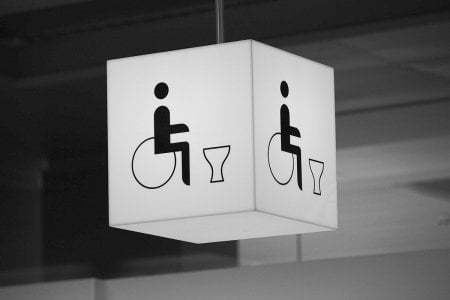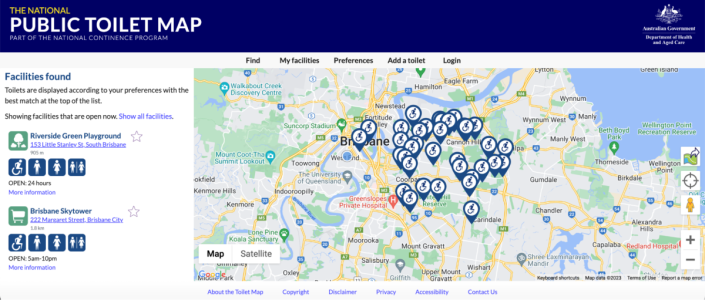Disability advocate calls for urgent action to address public bathroom shortage
- Replies 3
These days there’s no getting away from the fact that our world has been completely transformed by technology.
From making communication easier and travel more seamless to bringing shopping experiences to our doorsteps, life is certainly much, much easier thanks to modern conveniences.
However, a lot of local problems haven't received a whole lot of attention.
Take, for example, the lack of serviceable public toilets in some parts of Australia—a serious issue for the elderly, disabled, and families that needs to be addressed urgently.
Port Adelaide, for instance, has a growing population but has only two public toilets that are more than a kilometre apart.
The only operational public bathroom in the main business district is an old facility located behind the visitor centre and is locked after hours. The other is an automated facility containing one toilet at Harts Mill.
This is why disability advocate and business owner Shane Hryhorec has decided to take action and launch an initiative to get the local council to install more public bathrooms.
'There's a huge need for more bathrooms in this area,' he said. 'The port is getting busier, more and more people are coming here, but the facilities and the bathrooms are not growing and improving with the population that's growing.
'There's a lot of people in the community that are frustrated by the bathrooms, including business owners. Because the council doesn't give public bathrooms for people to use, they end up going into the businesses.'
Mr Hyrhorec said the council was behind in providing access to adequate public toilets, especially at a time when the population is on the rise.
'It takes me 20 minutes to wheel there in my wheelchair,' he said. 'It is open all the time but it's very far for people to get to and at night it can be very dangerous going through the dark streets. Being an automatic bathroom, it's not a great experience … so if you're a person with a disability you use it if you have to use it, but it's not a preference.'
It's not only the disabled who are at a disadvantage, but the elderly as well. With just two bathrooms a kilometre apart, it makes it extremely challenging for older Australians to access the bathrooms, given the length of the walk. Researchers have found that longer distances from home make it difficult to plan trips out for more than an hour or so, given the lack of access to public toilets.
In fact, the lack of public toilets is such an issue that it's causing serious problems in many countries around the world, with people turning to urinating in the street when no other facility is available.
The issue of public toilets has become a significant focus for the City of Port Adelaide Enfield. Mayor Claire Boan has made it clear that the task of building and managing toilets is an expensive task.
‘While it might look simple, building and managing public toilets is an expensive task, which includes a lot of logistical issues alongside it involving the location, access, and ongoing management,’ Mayor Boan said in a statement.
She also highlighted the hurdles in land acquisition. ‘Building new toilets also requires us to find and purchase suitable public land in a really accessible location that is highly patronised, which can also be a challenge,’ she added.
‘Places such as Port Adelaide simply do not have the required space to build these facilities at the moment.’
However, the council is looking into ‘short-term creative options to address the lack of space in Port Adelaide to build these facilities,’ pending a more permanent solution, although details were not provided. The yearly cost of fixing vandalism alone is $11,000 per toilet, as cited by the City of Port Adelaide Enfield.
The City of Port Adelaide Enfield council has begun to take action by releasing a 10-year Public Toilet Plan and Mayor Claire Boan has said that discussions are underway to find suitable public land for new toilet facilities.
Meanwhile, Mr Hryhorec has encouraged the council to think outside the box by possibly turning car spaces into public bathrooms, noting that this is a great idea that is worth exploring.
Members, if you ever find yourself in Port Adelaide and in need of a public toilet, the easiest way to find one is to use The National Public Toilet Map.
This app will help you find over 19,000 public loos nationwide, complete with information on accessibility, hours, and extra facilities like showers and baby change rooms. You can search nearby or plan ahead, personalise results, and get directions via map or list. The app is available on iOS and Android devices.
Are you aware of other areas within Australia facing a public toilet shortage similar to that of Port Adelaide? Share your experiences and insights in the comments below!
From making communication easier and travel more seamless to bringing shopping experiences to our doorsteps, life is certainly much, much easier thanks to modern conveniences.
However, a lot of local problems haven't received a whole lot of attention.
Take, for example, the lack of serviceable public toilets in some parts of Australia—a serious issue for the elderly, disabled, and families that needs to be addressed urgently.
Port Adelaide, for instance, has a growing population but has only two public toilets that are more than a kilometre apart.
The only operational public bathroom in the main business district is an old facility located behind the visitor centre and is locked after hours. The other is an automated facility containing one toilet at Harts Mill.
This is why disability advocate and business owner Shane Hryhorec has decided to take action and launch an initiative to get the local council to install more public bathrooms.
'There's a huge need for more bathrooms in this area,' he said. 'The port is getting busier, more and more people are coming here, but the facilities and the bathrooms are not growing and improving with the population that's growing.
'There's a lot of people in the community that are frustrated by the bathrooms, including business owners. Because the council doesn't give public bathrooms for people to use, they end up going into the businesses.'
Mr Hyrhorec said the council was behind in providing access to adequate public toilets, especially at a time when the population is on the rise.
'It takes me 20 minutes to wheel there in my wheelchair,' he said. 'It is open all the time but it's very far for people to get to and at night it can be very dangerous going through the dark streets. Being an automatic bathroom, it's not a great experience … so if you're a person with a disability you use it if you have to use it, but it's not a preference.'
It's not only the disabled who are at a disadvantage, but the elderly as well. With just two bathrooms a kilometre apart, it makes it extremely challenging for older Australians to access the bathrooms, given the length of the walk. Researchers have found that longer distances from home make it difficult to plan trips out for more than an hour or so, given the lack of access to public toilets.
In fact, the lack of public toilets is such an issue that it's causing serious problems in many countries around the world, with people turning to urinating in the street when no other facility is available.
The issue of public toilets has become a significant focus for the City of Port Adelaide Enfield. Mayor Claire Boan has made it clear that the task of building and managing toilets is an expensive task.
‘While it might look simple, building and managing public toilets is an expensive task, which includes a lot of logistical issues alongside it involving the location, access, and ongoing management,’ Mayor Boan said in a statement.
She also highlighted the hurdles in land acquisition. ‘Building new toilets also requires us to find and purchase suitable public land in a really accessible location that is highly patronised, which can also be a challenge,’ she added.
‘Places such as Port Adelaide simply do not have the required space to build these facilities at the moment.’
However, the council is looking into ‘short-term creative options to address the lack of space in Port Adelaide to build these facilities,’ pending a more permanent solution, although details were not provided. The yearly cost of fixing vandalism alone is $11,000 per toilet, as cited by the City of Port Adelaide Enfield.
The City of Port Adelaide Enfield council has begun to take action by releasing a 10-year Public Toilet Plan and Mayor Claire Boan has said that discussions are underway to find suitable public land for new toilet facilities.
Meanwhile, Mr Hryhorec has encouraged the council to think outside the box by possibly turning car spaces into public bathrooms, noting that this is a great idea that is worth exploring.
Members, if you ever find yourself in Port Adelaide and in need of a public toilet, the easiest way to find one is to use The National Public Toilet Map.
This app will help you find over 19,000 public loos nationwide, complete with information on accessibility, hours, and extra facilities like showers and baby change rooms. You can search nearby or plan ahead, personalise results, and get directions via map or list. The app is available on iOS and Android devices.
Are you aware of other areas within Australia facing a public toilet shortage similar to that of Port Adelaide? Share your experiences and insights in the comments below!










